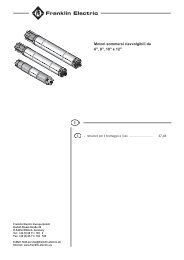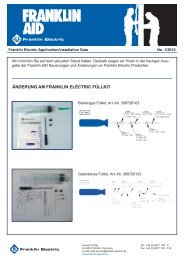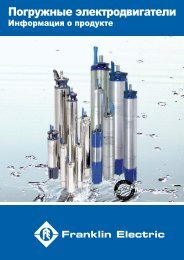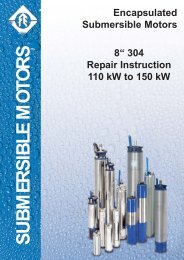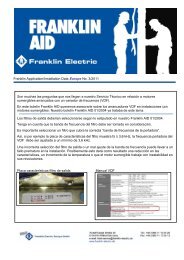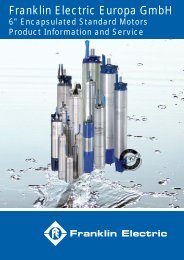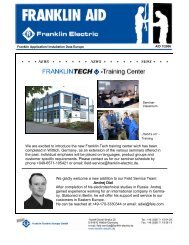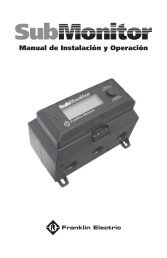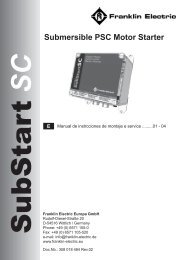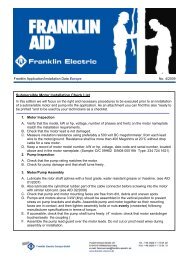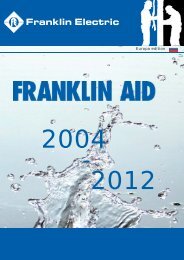AID - Franklin Electric Europa
AID - Franklin Electric Europa
AID - Franklin Electric Europa
Create successful ePaper yourself
Turn your PDF publications into a flip-book with our unique Google optimized e-Paper software.
<strong>Franklin</strong> Application/Installation Data EuropeNo. 4 / 2004This edition will highlight: “The Construction of Submersible Motors Part 2 : Mechanical Design”Technically speaking, the submersible motor is an asynchronous motor, featuring a stator, a rotor and bearings justlike any other above ground motor. Its mechanical design however needs to account for the very specific environmentand load that it has to carry: it lives its life under water, in narrow boreholes, with sometimes aggressivechemical behaviour or high dissolved solid contents. The motor drives a multistage submersible pump that bydesign exercises a certain downward oriented thrust load on the motor shaft. Thus, a submersible motor is of slim,long shape, with two or more radial bearings to center the rotor and an additional thrust bearing to carry the pumpload. Its constituting materials in contact with the environment are of corrosion resistant materials. A shaft sealkeeps the filling liquid inside and a pressure equalizing diaphragm allows for its heat expansion.In more detail: Bearing SystemEspecially the rotor bearing design in submersible motors is of particular interest: Normally, ball bearings would beused for radial purpose and angular contact bearings for combined radial/thrust loads. As in submersible motors itis desirable to have water-based cooling and lubrication fillings, ball bearings are not the first option, although theyare used in the oil-filled design. Also, as already discussed, because of high pulling costs, lifetime without the needof maintenance is of major concern. Considering the above, slide bearings have been found to offer theoreticallyunlimited lifetime with best behaviour in water-based lubrication. For both Encapsulated and Rewindable submersiblemotors, <strong>Franklin</strong> <strong>Electric</strong> uses hydrodynamic slide bearings. Our radial bearings consist of stainless steel shaftsleeves and carbon journals as bearing partners. When the rotor comes to speed, a water cushion is built upbetween the stationary carbon journal and the rotating stainless steel sleeve, so there is virtually no mechanicalcontact between the two components and consequently no wear. The thrust bearing also makes use of the samematerials: it consists of a rotating carbon disc and a number of stationary, tilting stainless steel pads. In normaloperation, a very thin water film is drawn between the pads and the carbon disc, which makes the thrust disc to“float” over the pads. This is comparable with the “aquaplaning” phenomenon known to most automobile drivers,and again results in theoretically no wear and long, maintenance-free bearing life. Obviously, it has to be made surethat the original filling liquid does not get contaminated with solids, and here is where the shaft seal steps in. Sealing systemThe inner part of the motor is filled with liquid for the purpose of lubrication, cooling and pressure equalization. Thisfilling operation is performed at the factory with a water-based, clean filling liquid. Ideally, this liquid will not beexchanged for the entire lifetime of the submersible motor. To guarantee this, all joints of the motor are equippedwith sealing components such as O-rings, flat gaskets and a lip- or mechanical seal for the shaft. To protect theseal from excessive wear by solids in suspension which are normally observed in well water, a sand slinger is fittedon the shaft to cover the seal area. Submersible motors also need a volume compensating diaphragm that allowsfor the heat expansion of the filling liquid captured inside the motor. As a positive side effect, the diaphragm alsoequalizes the pressure inside and outside of the motor for the various submergence depths.The next edition will continue with leads and lightning arrestors.<strong>Franklin</strong> <strong>Electric</strong> <strong>Europa</strong> GmbHRudolf Diesel Straße 20D-54516 Wittlich/GermanyTel.: +49 (0)65 71 10 54 20Fax: +49 (0)65 71 10 55 13e-mail: field-service@franklin-electric.dewww.franklin-electric.de




